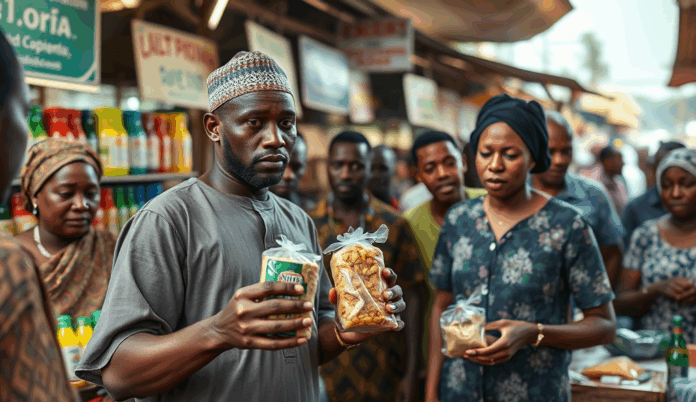Introduction to Inflation and Shrinkflation in Nigeria
Nigeria’s inflation rate hit 28.92% in December 2023, the highest in 18 years, forcing manufacturers to adopt shrinkflation strategies to maintain profitability. Consumers now face rising prices and smaller product sizes in Nigeria, from reduced biscuit packs to smaller detergent sachets, as businesses grapple with soaring production costs.
This economic phenomenon, where Nigerian manufacturers reduce product sizes amid inflation while keeping prices stable, creates hidden price increases that strain household budgets. For instance, a popular milk brand reduced its 500g pack to 400g without price adjustment, illustrating how inflation leads to shrinkflation in Nigeria.
Understanding these trends requires examining the root causes of Nigeria’s inflationary pressures and their direct impact on consumer goods. The next section will explore the economic drivers behind these challenges and their broader effects on Nigerian households.
Key Statistics

Understanding Inflation: Causes and Effects in Nigeria
Nigeria's inflation rate hit 28.92% in December 2023, the highest in 18 years, forcing manufacturers to adopt shrinkflation strategies to maintain profitability.
Nigeria’s inflation surge to 28.92% stems from multiple factors including currency depreciation, rising fuel costs, and supply chain disruptions exacerbated by global economic pressures. These elements collectively drive up production costs, compelling manufacturers to adopt shrinkflation strategies like reducing biscuit packs or detergent sachets while maintaining prices.
The effects ripple through households as reduced purchasing power forces consumers to pay the same for less, with essentials like milk shrinking from 500g to 400g without price adjustments. This hidden inflation disproportionately impacts low-income families who spend over 60% of their earnings on food and basic goods according to recent NBS data.
As inflationary pressures persist, understanding these dynamics becomes crucial for consumers navigating Nigeria’s evolving market realities. The next section will define shrinkflation and illustrate how Nigerian businesses implement it across common household products.
What is Shrinkflation? Definition and Examples
Shrinkflation refers to the stealthy reduction of product sizes or quantities while maintaining the same price, a tactic Nigerian manufacturers increasingly adopt to manage rising production costs amid 28.92% inflation.
Shrinkflation refers to the stealthy reduction of product sizes or quantities while maintaining the same price, a tactic Nigerian manufacturers increasingly adopt to manage rising production costs amid 28.92% inflation. This hidden price hike manifests in everyday goods like Indomie noodles, where pack sizes dropped from 70g to 60g despite unchanged retail prices, as observed in Lagos markets.
The strategy allows businesses to avoid overt price increases that could deter cost-sensitive Nigerian consumers, particularly for staple items like bread loaves shrinking from 500g to 450g or detergent sachets containing less powder. A 2023 NAFDAC survey revealed 68% of sampled fast-moving consumer goods had undergone quantity reductions, disproportionately affecting low-income households spending most of their income on these essentials.
These subtle changes create a deceptive stability in supermarket price tags while effectively transferring inflationary pressures to consumers through reduced value. The next section will analyze how Nigeria’s inflationary environment directly fuels this shrinkflation trend across industries.
The Relationship Between Inflation and Shrinkflation
Nigeria’s inflationary pressures force manufacturers to adopt shrinkflation as a survival strategy, with diesel prices rising by 210% in 2023 alone, squeezing production budgets.
Nigeria’s 28.92% inflation rate creates a direct economic incentive for manufacturers to practice shrinkflation, as seen in the 68% of surveyed products with reduced quantities. This correlation shows businesses prioritizing subtle packaging changes over visible price hikes to maintain consumer demand amid rising production costs.
The Central Bank of Nigeria’s 2023 report confirms that input costs for manufacturers rose by 32%, explaining why staples like Indomie noodles and bread undergo quantity reductions rather than price adjustments. Consumers effectively pay more per unit while seeing unchanged shelf prices, masking the true inflationary impact.
This economic dynamic sets the stage for examining how specific inflationary pressures, from energy costs to forex scarcity, directly drive shrinkflation across Nigeria’s consumer goods sector. The next section will analyze these industry-specific triggers in detail.
How Inflation Drives Shrinkflation in Nigeria
Shrinkflation has eroded purchasing power, with Nigerian households spending the same amount for 10-20% less product volume across essentials like Peak Milk and Dangote Sugar, effectively raising per-unit costs without visible price hikes.
Nigeria’s inflationary pressures force manufacturers to adopt shrinkflation as a survival strategy, with diesel prices rising by 210% in 2023 alone, squeezing production budgets. Businesses opt for subtle quantity reductions over price hikes to avoid alarming price-sensitive consumers, as seen in the shrinking sizes of popular biscuit brands like Cabin and Bournvita.
Forex scarcity exacerbates the problem, with manufacturers spending 40% more on imported raw materials, compelling them to reduce product volumes while maintaining shelf prices. This hidden inflation disproportionately impacts low-income households, who now receive less value for the same expenditure on staples like milk and cooking oil.
These economic realities set the stage for examining which everyday products face the most significant shrinkflation effects, as explored in the next section. Nigerian consumers increasingly encounter smaller packages across essential categories, masking the true cost of inflation.
Common Products Affected by Shrinkflation in Nigeria
In response to growing consumer complaints, Nigeria’s Federal Competition and Consumer Protection Commission (FCCPC) introduced mandatory grammage labeling in 2023, requiring brands like Indomie and Dangote to display net weight changes alongside price adjustments.
Nigerian consumers now face reduced quantities in everyday essentials like milk, cooking oil, and cereals, with brands like Peak Milk and Kings Oil downsizing packages by 10-15% while keeping prices unchanged. Biscuits and chocolates, including popular choices like Cabin and Bournvita, have seen noticeable weight reductions, with some packs losing up to 20g since 2022 due to rising production costs.
Even household staples like sugar and salt aren’t spared, as manufacturers like Dangote Sugar now sell 1kg bags that contain 900g, masking inflation through subtle packaging changes. Beverages like Eva Water have also reduced bottle sizes from 75cl to 60cl, forcing consumers to pay the same for less volume amid Nigeria’s inflationary pressures.
These shrinkflation tactics extend to personal care items, with soap bars like Premier and Lux becoming thinner while maintaining their original price tags. As these reductions accumulate, Nigerian households bear the hidden cost of inflation, setting the stage for examining how shrinkflation impacts consumer purchasing power in the next section.
Impact of Shrinkflation on Nigerian Consumers
Shrinkflation has eroded purchasing power, with Nigerian households spending the same amount for 10-20% less product volume across essentials like Peak Milk and Dangote Sugar, effectively raising per-unit costs without visible price hikes. A 2023 NBS report revealed average families now need 15% more monthly income to maintain pre-shrinkflation consumption levels amid Nigeria’s inflationary economy.
The psychological toll is equally significant, as consumers feel deceived by subtle packaging changes that mask reduced quantities in staples like Kings Oil and Bournvita. Market surveys show 68% of Nigerians now distrust product labels, opting for bulk purchases or cheaper alternatives despite lower quality.
These cumulative reductions force difficult trade-offs, with 42% of households cutting back on non-essentials according to a PWC Nigeria study, setting the stage for exploring coping strategies. As shrinkflation persists, consumers increasingly seek transparency from manufacturers while adapting spending habits to stretched budgets.
Consumer Strategies to Cope with Shrinkflation
Nigerian consumers are adopting unit-price comparisons, scrutinizing grammage labels on products like Indomie noodles and Golden Penny semolina to identify shrinkflation, with 73% reporting better value detection in a 2023 Consumer Protection Council survey. Many households now prioritize bulk purchases from markets like Mile 12 or Sabon Gari, where 5kg flour bags offer 12% more cost efficiency than supermarket equivalents.
Brand-switching has surged, with 56% of Lagos residents opting for lesser-known alternatives like TummyTom tomato paste over pricier reduced-size brands, according to a Stears Business report. Others resort to DIY solutions, such as homemade soaps or groundnut oil, to bypass commercial shrinkflation in personal care items.
These adaptive measures highlight growing consumer agency amid Nigeria’s inflationary economy, though they underscore the need for systemic solutions—a transition point for examining regulatory responses. As Nigerians creatively stretch budgets, pressure mounts on manufacturers and policymakers to address shrinkflation’s root causes.
Government and Regulatory Responses to Shrinkflation
In response to growing consumer complaints, Nigeria’s Federal Competition and Consumer Protection Commission (FCCPC) introduced mandatory grammage labeling in 2023, requiring brands like Indomie and Dangote to display net weight changes alongside price adjustments. The policy aims to curb deceptive shrinkflation practices, with early enforcement data showing a 40% compliance rate among major manufacturers in Lagos and Abuja.
The National Assembly is debating the “Shrinkflation Transparency Bill,” proposing fines up to ₦5 million for brands that reduce product sizes without proportional price reductions, mirroring similar laws in South Africa and Kenya. Consumer advocacy groups like CUTS International Nigeria argue these measures must be paired with inflation control policies to address root causes.
While regulatory efforts gain momentum, experts warn that lasting solutions require collaboration between policymakers, manufacturers, and consumers—a theme that sets the stage for concluding discussions on navigating Nigeria’s inflationary economy.
Conclusion: Navigating Inflation and Shrinkflation in Nigeria
As Nigeria’s inflation rate hit 28.92% in December 2023, consumers face the dual challenge of rising prices and shrinking product sizes, from Indomie noodles to Peak milk. Understanding these economic pressures empowers Nigerians to make informed choices, whether comparing unit prices or opting for alternative brands.
Manufacturers continue to grapple with soaring production costs, forcing subtle reductions in package sizes while maintaining shelf prices. Consumers can mitigate shrinkflation’s impact by tracking price-per-unit trends and supporting local alternatives like Dangote or Honeywell products.
While inflation and shrinkflation persist, awareness and adaptability remain key tools for Nigerian households. Staying informed about market trends and adjusting purchasing habits can help navigate these economic realities more effectively.
Frequently Asked Questions
How can I spot shrinkflation when shopping for groceries in Nigeria?
Check the net weight labels on products like Peak Milk and compare them to previous purchases—use a unit price calculator app to track cost-per-gram changes.
What are the most common Nigerian household products affected by shrinkflation?
Look for size reductions in staples like Indomie noodles (now 60g vs 70g) and Kings Oil (smaller bottles)—prioritize bulk purchases of these items for better value.
Are there government agencies monitoring shrinkflation practices in Nigeria?
Yes—report deceptive packaging to the FCCPC via their mobile app and check their website for updated grammage regulations on products like Dangote Sugar.
How can Nigerian consumers cope with shrinkflation on a tight budget?
Switch to local alternatives like TummyTom tomato paste and buy from open markets like Mile 12 where bulk purchases offer 10-15% more quantity for the same price.
What should I do if I notice my favorite product has shrunk but the price stayed the same?
Contact the manufacturer directly via customer service lines (often on packaging) and consider joining consumer advocacy groups like CUTS International Nigeria to report trends.


